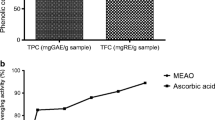Abstract
The hypolipidemic activity of Symplocos cochinchinensis S. Moore leaves was studied in Triton WR-1339- and high fat diet-induced hyperlipidemic rats. In Triton WR-1339-induced hyperlipidemic rats, the hexane extract (250 and 500 mg/kg) exerted a significant (P < 0.01) lipid-lowering effect compared to ethyl acetate and methanol extracts, as assessed by the reversal of the plasma levels of total cholesterol (TC), triglycerides (TG), high-density lipoprotein cholesterol (HDL-C), and low-density lipoprotein cholesterol (LDL-C). In high fat diet-fed hyperlipidemic rats, the hexane extract (250 and 500 mg/kg) caused the lowering of lipid levels in the plasma and liver. The hypolipidemic activity of S. cochinchinensis leaves was compared with fenofibrate, a known lipid-lowering drug, in both models.


Similar content being viewed by others
References
Yokozawa T, Ishida A, Cho EJ, Nakagawa T (2003) The effects of Coptidis rhizoma extract on a hypercholesterolemic animal model. Phytomedicine 10:17–22
Farias RAF, Neto MFO, Viana GSB, Rao VSN (1996) Effects of Croton cajucara extract on serum lipids of rats fed a high fat diet. Phytother Res 10:697–699
Chattopadhyaya R, Pathak D, Jindal DP (1996) Antihyperlipidemic agents. A review. Ind Drugs 33:85–98
Buenz EJ, Johnson HE, Beekman EM, Motley TJ, Bauer BA (2005) Bioprospecting Rumphius’s Ambonese Herbal herbal: volume I. J Ethnopharmacol 96:57–70
Ali M, Bhutani KK, Srivastava TN (1990) Triterpenoids from Symplocos racemosa bark. Phytochemistry 29:3601–3604
Ved DK, Goraya GS (2007) Demand and supply of medicinal plants in India. National Medicinal Plants Board/Foundation for Revitalisation of Local Health Traditions (FRLHT), New Delhi
Ishida J, Wang HK, Oyama M, Cosentino ML, Hu CQ, Lee KH (2001) Anti-AIDS agents. 46. Anti-HIV activity of Harman, an anti-HIV principle from Symplocos setchuensis, and its derivatives. J Nat Prod 64:958–960
Ahmad VU, Abbasi MA, Hussain H, Akhtar MN, Farooq U, Fatima N, Choudhary MI (2003) Phenolic glycosides from Symplocos racemosa: natural inhibitors of phosphodiesterase I. Phytochemistry 63:217–220
Khan MR, Kihara M, Omoloso AD (2001) Antimicrobial activity of Symplocos cochinensis. Fitoterapia 72:825–828
Vadivu R, Lakshmi KS (2008) In vitro and in vivo anti-inflammatory activity of leaves of Symplocos cochinchinensis (Lour) Moore ssp laurina. Bangladesh J Pharmacol 3:121–124
Li XH, Shen DD, Li N, Yu SS (2003) Bioactive terpenoids from Symplocos chinensis. Asian Nat Prod Res 5:49–56
Abbasi MA (2004) Bioactive chemical constituents of Symplocos recemosa and Comiphor amukul. PhD thesis submitted to University of Karachi, Pakistan
Lee KM (2001) Overview of drug product development. Curr Protoc Pharmacol 7:1–10
Roux S, Sablé E, Porsolt RD (2004) Primary observation (Irwin) test in rodents for assessing acute toxicity of a test agent and its effects on behavior and physiological function. Curr Protoc Pharmacol 10:1–23
Oliveira HC, dos Santos MP, Grigulo R, Lima LL, Martins DTO, Lima JCS, Stoppiglia LF, Lopes CF, Kawashita NH (2008) Antidiabetic activity of Vatairea macrocarpa extract in rats. J Ethnopharmacol 115:515–519
Levine S, Saltzman A (2007) A procedure for inducing sustained hyperlipemia in rats by administration of a surfactant. J Pharmacol Toxicol Methods 55:224–226
Harnafi H, Bouanani Nel H, Aziz M, Serghini Caid H, Ghalim N, Amrani S (2007) The hypolipidaemic activity of aqueous Erica multiflora flowers extract in Triton WR-1339 induced hyperlipidaemic rats: a comparison with fenofibrate. J Ethnopharmacol 109:156–160
Friedewald WT, Levy RI, Fredrickson DS (1972) Estimation of the concentration of low-density lipoprotein cholesterol in plasma, without use of the preparative ultracentrifuge. Clin Chem 18:499–502
Guido S, Joseph T (1992) Effect of chemically different calcium antagonists on lipid profile in rats fed on a high fat diet. Indian J Exp Biol 30:292–294
Ye J-C, Chang W-C, Hsieh DJ-Y, Hsiao M-W (2010) Extraction and analysis of β-sitosterol in herbal medicines. J Med Plants Res 7:522–527
Schurr PE, Schultz JR, Parkinson TM (1972) Triton induced hyperlipidemia in rats as an animal model for screening hypolipidemic drugs. Lipids 7:68–74
Zeniya M, Reuben A (1988) Triton WR-1339-induced changes in serum lipids and biliary lipid secretion. Am J Physiol Gastrointest Liver Physiol 254:G346–G354
Friedman M, Bayer SO (1957) The mechanism underlying hypocholesterolemia induced by Triton WR 1339. Am J Physiol 190:439–445
Patil UK, Saraf S, Dixit VK (2004) Hypolipidemic activity of seeds of Cassia tora Linn. J Ethnopharmacol 90:249–252
Khanna AK, Rizvi F, Chander R (2002) Lipid lowering activity of Phyllanthus niruri in hyperlipemic rats. J Ethnopharmacol 82:19–22
Anila L, Vijayalakshmi NR (2002) Flavonoids from Emblica officinalis and Mangifera indica-effectiveness for dyslipidemia. J Ethnopharmacol 79:81–87
Sudheesh S, Presannakumar G, Vijayakumar S, Vijayalakshmi NR (1997) Hypolipidemic effect of flavonoids from Solanum melongena. Plant Foods Hum Nutr 51:321–330
Hokanson JE, Austin MA (1996) Plasma triglyceride level is a risk factor for cardiovascular disease independent of high-density lipoprotein cholesterol level: a meta-analysis of population-based prospective studies. J Cardiovasc Risk 3:213–219
Pérez C, Canal JR, Campillo JE, Romero A, Torres MD (1999) Hypotriglyceridaemic activity of Ficus carica leaves in experimental hypertriglyceridaemic rats. Phytother Res 13:188–191
Xie W, Wang W, Su H, Xing D, Cai G, Du L (2007) Hypolipidemic mechanisms of Ananas comosus L. leaves in mice: different from fibrates but similar to statins. J Pharmacol Sci 103:267–274
Lees AM, Mok HYI, Lees RS, McCluskey MA, Grundy SM (1977) Plant sterols as cholesterol-lowering agents: clinical trials in patients with hypercholesterolemia and studies of sterol balance. Atherosclerosis 28:325–338
Mattson FH, Grundy SM, Crouse JR (1982) Optimizing the effect of plant sterols on cholesterol absorption in man. Am J Clin Nutr 35:697–700
Acknowledgments
The authors are grateful to the Entomology Research Institute, Chennai, India, for the financial assistance.
Author information
Authors and Affiliations
Corresponding author
Rights and permissions
About this article
Cite this article
Sunil, C., Ignacimuthu, S. & Kumarappan, C. Hypolipidemic activity of Symplocos cochinchinensis S. Moore leaves in hyperlipidemic rats. J Nat Med 66, 32–38 (2012). https://doi.org/10.1007/s11418-011-0548-4
Received:
Accepted:
Published:
Issue Date:
DOI: https://doi.org/10.1007/s11418-011-0548-4




